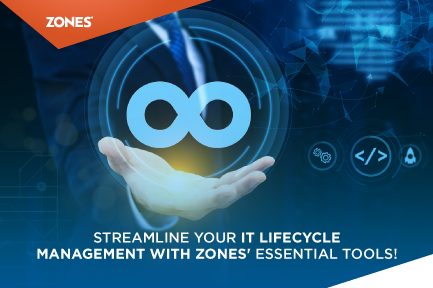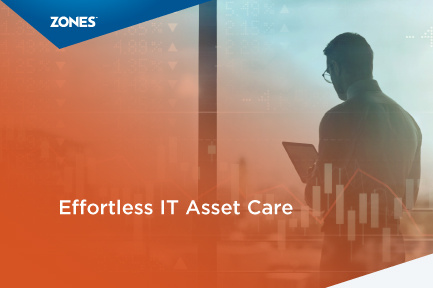Empowering SMBs for Cloud Success Through Simplified Migration
Migrating to the cloud is a complicated process, especially for small- and medium-sized businesses (SMBs) lacking the resources and expertise of...
4 min read
![]() Zones
:
Feb 6, 2024 3:03:42 PM
Zones
:
Feb 6, 2024 3:03:42 PM

Today, businesses operating across different locations face unique challenges in IT asset management (ITAM) with respect to tracking and managing inventory, maintenance, security, and logistics. Moreover, when organizations are spread globally across geographies, there are severe challenges related to procurement, configuration, disposal, licensing, repair & upgrade, compliance, and security risk, making IT asset and infrastructure management even more complex.
Here are some of the common challenges of multisite IT asset management
Managing IT assets across various sites involves dealing with diverse infrastructure, including different hardware configurations, network setups, and software environments. This diversity poses challenges to standardization.
The distributed nature of IT assets increases the risk of data breaches. With assets distributed across multiple sites, ensuring data resilience and quick recovery in case of disasters or system failures is difficult. This may lead to permanent data loss.
Multisite ITAM often requires navigating through diverse cultural norms and regulatory frameworks. Each region may have distinct compliance requirements and business practices, adding complexity to the overall management process.
Ensuring seamless integration of IT assets across various sites can be daunting. Differences in technology platforms, software versions, and communication protocols may impede the smooth functioning of integrated systems.
The decentralized nature of multisite operations can lead to a lack of visibility into the status and usage of IT assets. This lack of transparency makes it difficult for organizations to make informed decisions about upgrades, replacements, and resource allocations.
Implementing changes in IT assets, whether it be updates, upgrades, or replacements, can be challenging in a multisite environment. Ensuring that all sites adapt to changes simultaneously without disruptions is difficult in multisite IT environments.
These challenges underscore the need for organizations to adopt a holistic and adaptive approach to multisite IT Asset Management, addressing technical intricacies and cultural, regulatory, operational, and security complexities.
Additionally, effective multisite ITAM streamlines IT operations across locations while providing cost-optimization benefits. Gartner indicates that organizations can achieve cost savings of 10% to 20% by implementing comprehensive IT Asset Management practices.
Establishing a centralized and unified ITAM system is crucial to overcoming the challenge of diverse infrastructure. A centralized system provides a single point of control and visibility, allowing organizations to standardize processes and track assets consistently across multiple sites. This enables efficient hardware, software, and configuration management, reducing the complexities associated with diverse infrastructures.
Create a comprehensive inventory view of your IT assets to ensure a holistic view of your IT environment. This may require leveraging information from multiple locations and sources by:
Remember to capture all asset types such as servers, workstations, printers, routers, keyboards, projectors, VM, and VM hosts, along with asset parameters such as configuration type, asset current state, cost, expiration date, etc. Also, record software asset information, including licenses, software versions and categories, and service packs. Capturing extensive multisite hardware and equipment information can help make critical decisions and ensure smooth IT operations.
Organizations should implement a structured asset lifecycle management framework covering procurement, installation, usage, storage, and disposal. Each stage should be defined with associated statuses for tracking. Technologies such as barcodes, RFID, and GPS can be utilized to continuously track and maintain assets throughout their lifecycle. This can help avoid discrepancies in how the assets are handled across locations.
Centralize software and license information at a specific location to ensure optimum usage and compliance. This may involve examining existing software, expiration dates, contractual associations, and license types. Additionally, organizations can track installation, available licenses, and allocation of specific software. This can help ensure better multisite compliance through timely actions, such as purchasing new licenses or deleting unused applications.
Implementing standardized ITAM processes ensures consistency across multiple sites. The objective is clear: to establish uniformity in configurations, deployment practices, and maintenance procedures. This not only streamlines the management of diverse IT infrastructures but also acts as a strategic measure to mitigate the complexities that arise from variations in hardware configurations, network setups, and software environments.
Successful ITAM should seamlessly integrate with other IT service management (ITSM) practices. This includes mapping workstations to end users, building a comprehensive configuration management database (CMDB), and tying impacted assets to incidents, problems, and changes. This integration enhances efficiency and aids in incident resolution, problem analysis, and change management across locations.
A proactive security strategy is essential to address the diverse security challenges of managing IT assets across various locations. One key aspect of this strategy involves implementing robust encryption protocols. This is crucial for dealing with confidential information that flows between different sites, protecting it from interception or unauthorized access.
Access controls are another critical component of a comprehensive security approach. By implementing stringent access controls, organizations can regulate who has permission to view, modify, or manage IT assets. You can also have a continuous monitoring process to detect anomalies or potential security threats to prevent vulnerabilities across sites. Regular security training and awareness programs for employees across all sites can also be implemented.
Reporting and measuring key metrics are essential to avoid multisite ITAM challenges. Key metrics, such as average workstation costs, average software license cost, workstations by the operating system, depreciation rates of assets, average cost of asset maintenance, and the total value of assets, can be tracked through built-in standard reports or custom reports. These reports and dashboards displaying key metrics can help with informed decision-making for specific IT rollout requirements. This further enables a smooth and optimized ITAM process across multiple locations.
Overcoming resource allocation challenges necessitates the adoption of advanced automation and AI technologies. These technologies can automate asset discovery, inventory management, and compliance tracking.
Regular audits and compliance checks are essential for ensuring IT assets adhere to regulatory requirements. This proactive approach helps organizations identify and rectify potential compliance issues before they escalate. It also imparts IT asset visibility across locations. Moreover, conducting regular audits helps maintain control over your IT operations while serving as an early warning system related to IT failures, saving from fines and penalties and reducing discrepancies in the IT infrastructure.
Multisite ITAM is an ongoing process that requires contributions from all the spheres and levels of the business. Without a solid strategy in place, organizations risk inefficiencies, security vulnerabilities, and unnecessary costs.
For organizations operating across diverse locations and facing multisite ITAM challenges, adopting the best practices listed above is imperative. By adopting these practices, organizations can maximize efficiency, minimize risks, and foster a culture of continuous improvement across their multisite operations.
To get started with these practices, organizations can also create a checklist of systematic processes to be performed. In addition, you can also keep a review process to assess areas of improvement and opportunities to enhance further and evolve multisite IT management. This helps establish a robust IT Asset Management framework, ensuring operational excellence in the dynamic and geographically dispersed digital age.
If you want to streamline and centralize your IT asset and infrastructure management or elevate your ITAM strategy, check out our end-to-end IT lifecycle services
-1.jpg)
Migrating to the cloud is a complicated process, especially for small- and medium-sized businesses (SMBs) lacking the resources and expertise of...

Today, managing IT assets throughout their lifecycle has become a critical challenge for businesses of all sizes. Each stage of an IT asset's...

The optimal performance of data-bearing IT assets is crucial to an organization’s operational efficiency. This is why these assets require a secure...